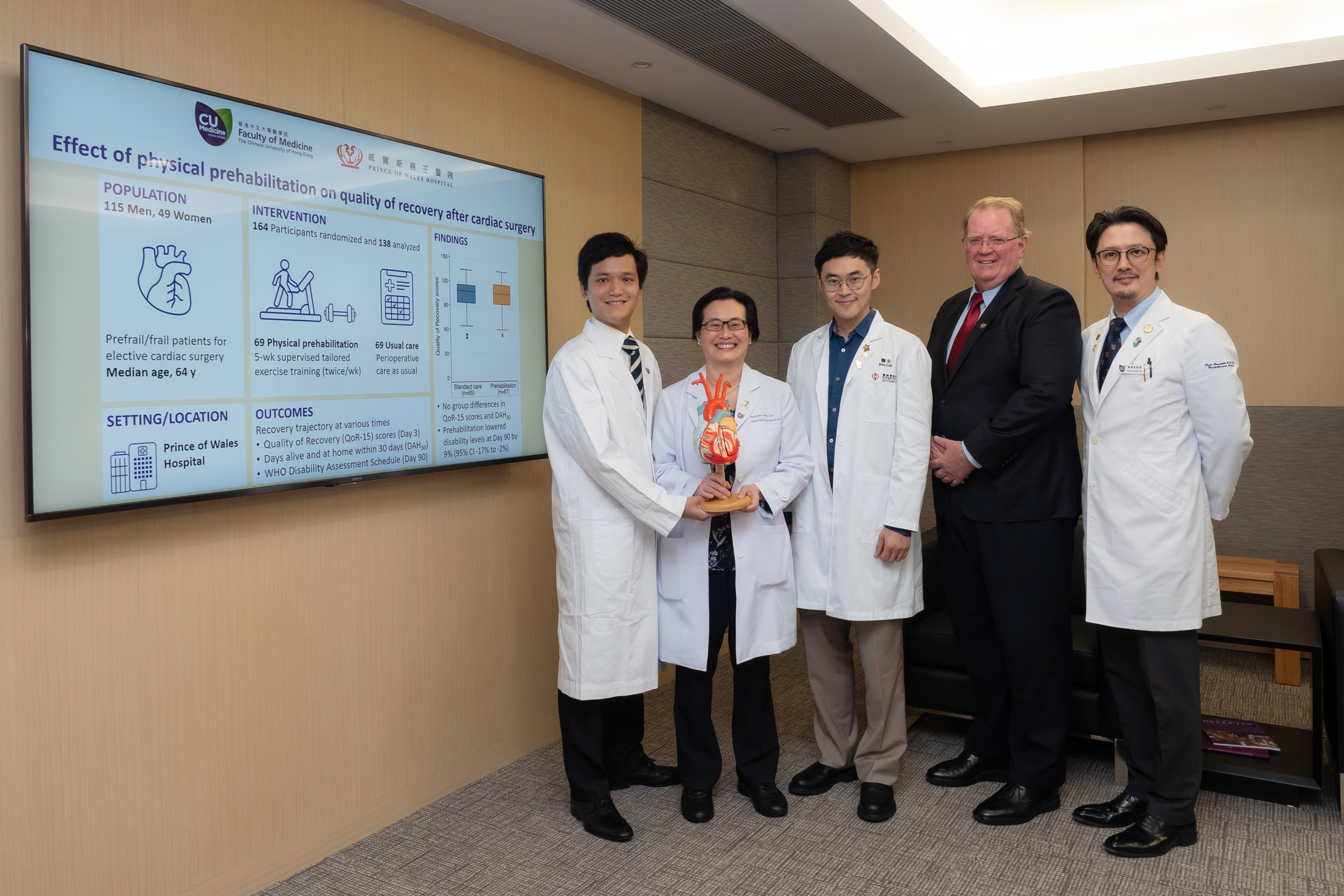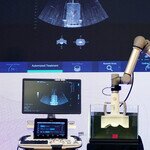CUHK finds physical prehabilitation can accelerate postoperative recovery in heart surgery patients
Major heart surgery places significant stress on the human body and can lead to complications, particularly in patients with limited physiological reserves. A recent study from The Chinese University of Hong Kong’s (CUHK) Faculty of Medicine (CU Medicine) highlights the benefits of regular exercise training several weeks before surgery, known as physical prehabilitation, in optimising the health status of vulnerable or frail patients. Researchers hope the study results will encourage hospitals to implement physical prehabilitation programmes for patients scheduled for elective heart surgery to improve outcomes and support a smoother recovery process. Study details have been published in the British Journal of Anaesthesia.

Research team members include (from left) Dr Derek Yau King-wai, Adjunct Assistant Professor and a senior physiotherapist, Professor Anna Lee, Dr Wong Man-kin, Clinical Associate Professor (honorary) and Professor Gavin Joynt in the Department of Anaesthesia and Intensive Care, and Professor Randolph Wong Hung-leung, Chief of the Division of Cardiothoracic Surgery, Department of Surgery at CU Medicine.
Study results advocate for physical prehabilitation programmes
The CU Medicine research team conducted a randomised, controlled trial between 2018 and 2023 to investigate the effects of a five-week, supervised exercise training programme on patients undergoing heart surgery. A total of 164 prefrail to moderately frail (Clinical Frailty Scale (CFS) of 4 to 6) patients, ranging in age from 34 to 79 years, were randomly assigned to a prehabilitation group, in which patients participated in a twice-weekly, physiotherapist-supervised physical exercise programme before undergoing heart surgery; or a usual care group, which involved standard hospital care without any physical prehabilitation before heart surgery. Both groups of patients received the usual hospital surgical, anaesthetic and nursing care before and after the surgery.
Professor Randolph Wong Hung-leung, the study’s co-author and Chief of the Division of Cardiothoracic Surgery, Department of Surgery at CU Medicine, explained: “We are observing a notable increase in patients who are sicker and frailer. Our cardiac physical prehabilitation programme is specifically designed to address the challenges these patients face, who are at a greater risk of complications during and after cardiac procedures.”
Results showed that, although the physical prehabilitation programme did not improve early quality of recovery scores after surgery, it successfully lowered disability levels, meaning less impairment in performing daily activities, by 9 percentage points at 90 days after surgery, compared to patients receiving the usual care without exercise training. The findings suggested that physical prehabilitation programmes could lead to faster recovery and an improved overall quality of life for patients following heart surgery.
The key findings of the study are as follows:
1. Patient Acceptance and Safety
- Patient acceptance of the five-week physical prehabilitation programme was high, with more than 80% of participants attending all the planned outpatient exercise training sessions.
- The prehabilitation programme was safe, with no substantial side effects reported during the study.
2. Early Recovery Outcomes
- No significant difference was found between the prehabilitation and usual care groups in terms of median quality of recovery scores on the third day after surgery (prehabilitation: 106 versus usual care: 109).
- There was also no difference between groups in the number of days spent at home within 30 days after surgery (prehabilitation: 20.5 days versus usual care: 21.5 days).
3. Long-Term Disability Levels
- At 90 days after surgery, the “prehabilitation group” had lower mean disability levels compared to the usual care group (prehabilitation: 5.3% versus usual care: 14.6%), representing a clinically meaningful difference of 9.3 percentage points.
First author of the study Dr Derek Yau King-wai, Adjunct Assistant Professor at CU Medicine’s Department of Anaesthesia and Intensive Care, and a senior physiotherapist, commented: “This groundbreaking study is the first of its kind to assess the impact of cardiac physical prehabilitation on patient-centred outcomes in vulnerable to moderately frail patients. Participants in the “prehabilitation group” were highly motivated and enjoyed their aerobic and resistance training sessions with us. The training regimen included activities such as treadmill walking, arm and leg cycling, stepping exercises, and the use of dumbbells or cuff weights to strengthen the major muscle groups in both the upper and lower limbs. This may explain why these patients were able to walk an average of 22 metres further than those in the usual care group during the six-minute walk test before surgery.”
Corresponding senior author of the study Professor Anna Lee, of CU Medicine’s Department of Anaesthesia and Intensive Care, concluded: “There is a widespread misconception that vigorous exercise is unsafe for frail patients with heart conditions before surgery. Our findings support the safety and effectiveness of cardiac physical prehabilitation for vulnerable to moderately frail patients when conducted under the careful supervision of a physiotherapist. The five-week physical prehabilitation programme showed its benefits by improving procedure-related adverse effects 90 days after surgery. Specifically, patients in the “prehabilitation group” experienced fewer difficulties in performing daily activities compared to those in the usual care group. We urge hospital administrators to allocate more resources toward implementing physical prehabilitation programmes before cardiac surgery procedures to enhance patient outcomes in the future.”









